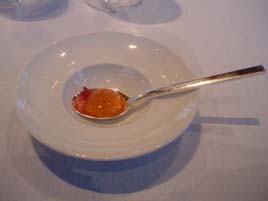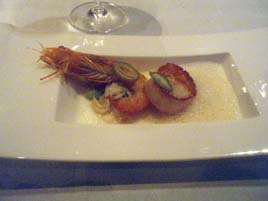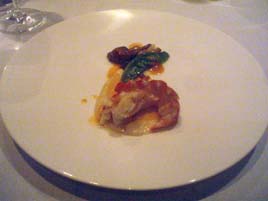Asiate
 Thursday, May 26, 2011 at 03:59PM
Thursday, May 26, 2011 at 03:59PM 
 You are not going to believe this review. I am writing from experience. Publish a favorable review of a restaurant totally off the media radar, and people say, “It just can’t be that good. This blogger doesn’t know what he’s talking about.”
You are not going to believe this review. I am writing from experience. Publish a favorable review of a restaurant totally off the media radar, and people say, “It just can’t be that good. This blogger doesn’t know what he’s talking about.”
Say it all you want, but I’m sticking to my guns. For a certain type of elegant, special-occasion dining experience, Asiate in the Mandarin Oriental Hotel is superb. It does not warrant the 3½ stars I improvidently awarded it 5½ years ago. But neither does it deserve the one-star slam Amanda Hesser dumped on it in 2004. The argument is where in between Asiate should go.
No one, I think, will dispute that the room is beautiful, and the panoramic view over Central Park is perhaps the city’s best. Asiate is perennially at the top of the Zagat rating for décor, with 29 out of 30 points. (It gets 24 points for food and 25 for service, both well above average.)
But it is completely off the food media radar. Asiate doesn’t even try to get attention. Between hotel guests and those lured by lofty Zagat ratings, the restaurant doesn’t need any help: it was close to full on a Tuesday evening.
After the initial round of reviews in 2004, Asiate received practically no media mentions I’m aware of, aside from a review eighteen months ago by Alan Richman in QG. He was peeved—as I certainly would have been—when he requested a window table, called back to confirm he’d be getting one, and was still not seated near the window. (Besides that, he thought Asiate “in some ways . . . excellent.”)
Nothing like that happened to us: we were offered the choice and chose the window. Who wouldn’t?
The name—pronounced AH–zee–ott—suggests a vaguely Asian theme, translated as Western produce with pan-Asian spices and accents. Once upon a time, it would have been called Asian fusion, before that term went out of fashion. The opening chef is long gone. Brandon Kida is the current chef de cuisine. Although he’s been there from the restaurant’s inception, the menu is much changed from the one I wrote about in 2005. There’s no sign of the nouvelle cuisine that Amanda Hesser hated.
Asiate charges three-star prices: $85 for a three-course prix fixe, or $125 for an eight-course tasting menu. The tasting menu, which we had, is the better deal, in that it includes three dishes that normally carry supplements, albeit smaller portions of them.


It’s almost evil to plop down a dozen warm gougères (above left) in front of two hungry people. The bread service (above right) is very good, but the butter was cold.


The amuse bouche (above left) is a dainty fruit sphere, which explodes in your mouth. The first course (above right) was a quintet of tartares and crudi.


“Buckwheat and Eggs” (above left) is, I assume, a miniature version of an appetizer with the identical description that carries an $85 supplement on the prix fixe menu. It was also the evening’s best dish: soba noodles, Osetra caviar, and uni cream, all in superb balance.
Balance, indeed, torpedoed the next dish (above right), with a scallop, blue prawn, and crab meat. The individual ingredients were well prepared, but there was no idea that brought them together.


Sea Bass (above left) was beautifully done, complemented by a lovely ginger consommé. Butter poached lobster (above right) was slightly tough, and the accompanying vegetables had a grab-bag quality. (Compare the version of it that we had at Ai Fiori, which was much better.) But the same dish has disappointed me at Per Se, too.


Wagyu beef tenderloin (above left) can always be counted on for default luxury, and it was indeed excellent—perfect, really. The vegetables, again, had that grab bag quality.
 Why serve one dessert when you can serve five (above right)? They were all good (if unremarkable), perhaps topped by the carrot cake (top left in the photo). And as it was my friend’s birthday, an extra piece of cake was on the house.
Why serve one dessert when you can serve five (above right)? They were all good (if unremarkable), perhaps topped by the carrot cake (top left in the photo). And as it was my friend’s birthday, an extra piece of cake was on the house.
The wine list is a hefty tome and would repay repeated visits, if for no other reason. A 1981 Eitels Riesling was $95, which struck me as a very good price. (Afterward, I saw the 1990 vintage on the web at $60.)
Service in the dining room was excellent, once we were seated. But as Richman reported two years ago, the staff seem to have trouble finding you in the adjoining bar, even when you’ve checked in and told them you’re there. Service at said bar is too slow, bearing in mind the $19 tariff for a cocktail. But I loved the one I had, the Baby Buddha (Hendrick’s gin, fresh cucumber, cilantro, sake).
A tasting menu that offers Asiate’s greatest hits might not be typical of the average diner’s experience, ordering off of the prix fixe. But this was certainly a very good meal, one I wouldn’t hesitate to recommend.
Asiate (Mandarin Oriental Hotel, 80 Columbus Circle at 60th Street, 35th floor)
Food: **½
Service: ***
Ambiance: ****
Overall: **½


